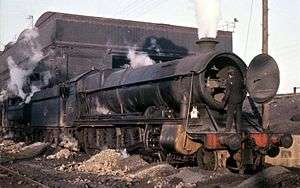GWR 4700 Class
|
GWR Class 4700 2-8-0 4706 at Old Oak Common MPD, London, on 15 December 1963 | |||||||||||||||||||||||||||||||||||||||||||||||||||||||
| |||||||||||||||||||||||||||||||||||||||||||||||||||||||
| |||||||||||||||||||||||||||||||||||||||||||||||||||||||
| |||||||||||||||||||||||||||||||||||||||||||||||||||||||
| |||||||||||||||||||||||||||||||||||||||||||||||||||||||
The Great Western Railway (GWR) 4700 Class was a class of nine 2-8-0 steam locomotives, designed by George Jackson Churchward. They were introduced in 1919 for heavy mixed traffic work. Although primarily designed for fast freight, the class also sometimes hauled passenger trains, notably heavy holiday expresses in the summer months.
Background
At the end of the First World War, the running department of the GWR identified the need for a larger version of the successful GWR 4300 Class 2-6-0 incorporating the Swindon No. 1 boiler. They envisaged a smaller version of the successful Saint class 4-6-0 with 5 ft 8 in (1.727 m) driving wheels - the intermediate of Churchward's three standard wheel sizes, for express goods trains. However, Churchward preferred a 2-8-0 design for this purpose[1]
Prototype
The prototype of the new class was built at Swindon railway works in May 1919 (Lot 214) and was the last design by Churchward. It was numbered 4700. According to the RCTS monograph, the design was not successful as built because the No.1 boiler proved to be inadequate for such a large engine.[2] In May 1921 it was therefore rebuilt with a newly designed and larger Swindon No. 7 boiler. However, according to Cook it was built with a Standard No. 1 boiler as the intended design of a larger boiler, the Standard No. 7, was not yet ready.[3]
Production Series
Eight further locomotives with the larger No. 7 boilers and detail differences were ordered by Churchward in 1921 (Lot 221), but these only appeared after his retirement. These were numbered 4701 to 4708. Although they were mechanically successful locomotives, their large size severely restricted their route availability and so no more examples were built. Churchward’s successor Charles Collett later rebuilt a Saint Class with 6 ft 0 in (1.829 m) wheels to form the Hall Class which was a far more versatile mixed traffic locomotive.[4] Later, Collett would produce the 6800 Grange Class which was exactly as the traffic department had originally envisaged: a 4-6-0 with Std. No.1 boiler and 5'8" driving wheels. The class were originally fitted with 3,500 imperial gallons (16,000 l; 4,200 US gal) tenders but during 1933/4 these were replaced by 4,000 imperial gallons (18,000 l; 4,800 US gal) tenders.
Use
The class were primarily used on fast overnight freight services on the London, Exeter and Plymouth, London-Bristol and London, Birmingham and Wolverhampton routes. In later years they were often used on heavy relief passenger services to the West of England during the summer months.
Accidents and incidents
On 12 November 1958, locomotive No. 4707 was hauling a freight train when it overran signals and was derailed at Highworth Junction, Swindon, Wiltshire. A newspaper train collided with the wreckage.[5]

Withdrawal
Withdrawal of the class began in June 1962 with No.4702, while the last were removed from service in May 1964. As a result of their limited usefulness, the mileages achieved by the class were not great with No.4705 recorded the greatest at 1,656,564 miles (2,665,981 km).
Preservation
No members of the class were preserved. However, the Great Western Society made the decision to create the next locomotive in the sequence, 4709. Supported via a GWS sub-group, it is being built using a mixture of new parts and others recycled from former Barry scrapyard locomotives:
- GWR 5101 class 2-6-2T 4115 - six of the eight driving wheels and the frame extension.[6]
- GWR 2800 class 2-8-0 2861 - the cylinder block.
- GWR 5205 class 2-8-0T 5227 - the axleboxes, horns, fourth axle (axle only) and other various components.
The plates for the new frames were cut and machined in 2012, and 4709 is now under construction at Llangollen, alongside other new-build projects: 61673 Spirit of Sandringham, 6880 Betton Grange, and 45551 The Unknown Warrior.
References
- ↑ le Fleming, H.M. (November 1960) [1953]. White, D.E., ed. The Locomotives of the Great Western Railway, part eight: Modern Passenger Classes (2nd ed.). Kenilworth: RCTS. pp. H29.
- ↑ Le Fleming, H.M. (1962). The Locomotives of the Great Western Railway, part nine: Standard two-cylinder Classes. Kenilworth: RCTS. pp. J24–5. ISBN 0901115371.
- ↑ Cook, K.J. (1974). Swindon Steam. Ian Allan.
- ↑ Le Fleming 1962, p. J25
- ↑ Trevena, Arthur (1980). Trains in Trouble. Vol. 1. Redruth: Atlantic Books. p. 47. ISBN 0-906899-01-X.
- ↑ The 5199 Project (2011). "5199 Project". 5199.co.uk. Retrieved 2011-07-25.
- "Great Western Locomotive Types, 47xx". Retrieved 2006-01-01.
- Daniel, John (2000). "Great Western steam locomotives, '4700' class". The Great Western Archive. Retrieved 2006-01-01.
- Overton, Tim. "GWR Locomotive Evolution". Archived from the original on August 21, 2004. Retrieved 2006-01-01. (Version from WayBack Machine (as of 27 April 2006))
- Whitehurst, Brian (1973). Great Western engines, names, numbers, types, classes: 1940 to preservation. Oxford: Oxford Publishing Company. pp. 42, 103, 138. ISBN 0-902888-21-8. OCLC 815661.
